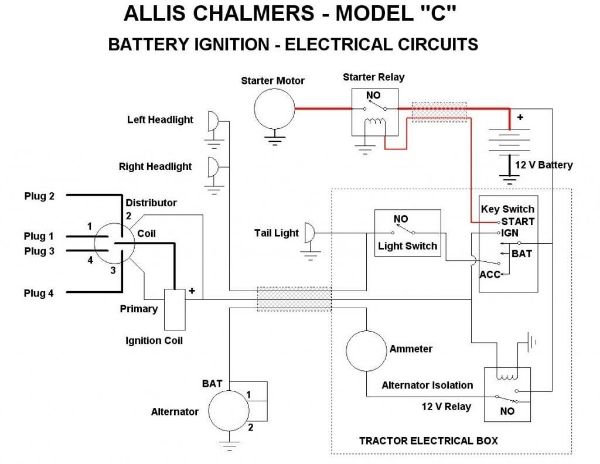| Author |
 Topic Search Topic Search  Topic Options Topic Options
|
Billy Ray 
Bronze Level

Joined: 09 Dec 2009
Location: Kinard, Florida
Points: 85
|
 Post Options Post Options
 Thanks(0) Thanks(0)
 Quote Quote  Reply Reply
 Topic: positive ground Topic: positive ground
Posted: 05 May 2017 at 7:47pm |
|
attempting to start a "B" I realized the battery cables were reversed, positive ground and hot negative. The tractor started and ran like this but I had to change the carb and when I finished the carb, it would not start. it has been converted from 6 volt to 12 volt and has an alternator. Can I just switch the cables or is there more changing to do?
|
 |
|
Sponsored Links
|
|
 |
Larry in NC 
Orange Level

Joined: 09 Feb 2016
Location: NC
Points: 1048
|
 Post Options Post Options
 Thanks(0) Thanks(0)
 Quote Quote  Reply Reply
 Posted: 05 May 2017 at 8:05pm Posted: 05 May 2017 at 8:05pm |
|
I assume you mean that the engine is not turning over after you finished the carb install? With a 12 volt alternator, the negative ground would be correct. Just switch the cables. The starter will work either way, positive or negative. If the starter still does not work, check all of the connections.
|
 |
Billy Ray 
Bronze Level

Joined: 09 Dec 2009
Location: Kinard, Florida
Points: 85
|
 Post Options Post Options
 Thanks(0) Thanks(0)
 Quote Quote  Reply Reply
 Posted: 05 May 2017 at 8:09pm Posted: 05 May 2017 at 8:09pm |
|
The engine will turn over but the battery is too weak to turn it fast enough to start. So I can change the cables and hook up the jump box to start it without hurting anything else?
|
 |
steve(ill) 
Orange Level Access


Joined: 11 Sep 2009
Location: illinois
Points: 81041
|
 Post Options Post Options
 Thanks(0) Thanks(0)
 Quote Quote  Reply Reply
 Posted: 05 May 2017 at 8:23pm Posted: 05 May 2017 at 8:23pm |
|
yes, just like a truck... Positive to the starter lug ( assuming you have the old push rod/ starter switch setup... negative to ground.. Do you have a magneto or distributor ? Mag will start, no problem.. If its a distributor, you need a positive wire from key or on switch, to the coil, and a wire out of the coil to the distributor point... then it will start.
|
|
Like them all, but love the "B"s.
|
 |
Billy Ray 
Bronze Level

Joined: 09 Dec 2009
Location: Kinard, Florida
Points: 85
|
 Post Options Post Options
 Thanks(0) Thanks(0)
 Quote Quote  Reply Reply
 Posted: 05 May 2017 at 8:27pm Posted: 05 May 2017 at 8:27pm |
|
It has a mag and an alternator
|
 |
garden_guy 
Orange Level

Joined: 05 Jul 2013
Location: Illinois
Points: 1133
|
 Post Options Post Options
 Thanks(0) Thanks(0)
 Quote Quote  Reply Reply
 Posted: 05 May 2017 at 8:28pm Posted: 05 May 2017 at 8:28pm |
|
May also find that the way it is wired is draining your battery and that is why it won't start. My 12V WD has a cutoff switch on top of the key switch to keep it from draining the battery, and once tractor is started I have to pull the switch to engage the alternator charging.
|
 |
CTuckerNWIL 
Orange Level


Joined: 11 Sep 2009
Location: NW Illinois
Points: 22823
|
 Post Options Post Options
 Thanks(0) Thanks(0)
 Quote Quote  Reply Reply
 Posted: 05 May 2017 at 8:44pm Posted: 05 May 2017 at 8:44pm |
|
If you have a negative ground alternator, and you had it hooked up and cranking with the positive to ground, you MAY need a new alternator.
IF by chance the alternator was made for a positive ground, switching the cables around, will probably fry it?
|
|
|
 |
Billy Ray 
Bronze Level

Joined: 09 Dec 2009
Location: Kinard, Florida
Points: 85
|
 Post Options Post Options
 Thanks(0) Thanks(0)
 Quote Quote  Reply Reply
 Posted: 05 May 2017 at 8:46pm Posted: 05 May 2017 at 8:46pm |
|
I don't know about that, I just bought the tractor and found this trouble.
|
 |
DougS 
Orange Level


Joined: 03 Nov 2011
Location: Iowa
Points: 2490
|
 Post Options Post Options
 Thanks(0) Thanks(0)
 Quote Quote  Reply Reply
 Posted: 05 May 2017 at 8:49pm Posted: 05 May 2017 at 8:49pm |
|
If it has an alternator and the battery cables got reversed your alternator is probably fried. Alternators are usually set up for negative ground, but there are rare execptions.
|
 |
Gerald J. 
Orange Level

Joined: 12 Sep 2009
Location: Hamilton Co, IA
Points: 5636
|
 Post Options Post Options
 Thanks(0) Thanks(0)
 Quote Quote  Reply Reply
 Posted: 05 May 2017 at 9:38pm Posted: 05 May 2017 at 9:38pm |
|
Reversing the battery polarity with the normal negative ground alternator (prescribed by SAE standard since about 1963) will run the battery down very rapidly and likely destroy the rectifiers inside the alternator.Neither is likely to survive.
Gerald J.
|
 |
Steve in NJ 
Orange Level Access


Joined: 12 Sep 2009
Location: Andover, NJ
Points: 11788
|
 Post Options Post Options
 Thanks(0) Thanks(0)
 Quote Quote  Reply Reply
 Posted: 06 May 2017 at 10:13am Posted: 06 May 2017 at 10:13am |
|
Oh boy! Not good. If the Alt survived with the polarity backwards, it would be a miracle. Like the guys mentioned, isn't gonna hurt the Starter any. Most Alts are Neg. ground, (unless I built one for pos. grd) Store bought, Negative. With Mag equipped Tractors on 12V's there's always that possibility that the engine will spin over to fast for the impulse. Some folks have had that problem and the past. The fast moving 12V current overrides the impulse not allowing the impule to engage and the engine to fire off. Doesn't happen to all Tractors with Mags, but some it does. HTH
For some tips on 12V systems, visit our website. There's lots of information on 12V systems and how they should be hooked up.
Steve@B&B
bb-customcircuits.com
|
|
39'RC, 43'WC, 48'B, 49'G, 50'WF, 65 Big 10, 67'B-110, 75'716H, 2-620's, & a Motorhead wife
|
 |
Gerald J. 
Orange Level

Joined: 12 Sep 2009
Location: Hamilton Co, IA
Points: 5636
|
 Post Options Post Options
 Thanks(0) Thanks(0)
 Quote Quote  Reply Reply
 Posted: 06 May 2017 at 12:19pm Posted: 06 May 2017 at 12:19pm |
|
Somewhere I have a Delco manual on alternators and it admits making positive ground, but the SAE standard pretty much makes all easily found alternators negative ground. That SAE standard change came along about the same time as transistor radios. Tube radios survived wrong polarity, just didn't work sometimes. Transistor radios burn up transistors faster than the fuses blew.
I have Leece-Neville alternator that has the negative post circuit insulated so it can be either polarity and there were some of those with external rectifiers to be easily used for positive ground. Its big, probably made for a truck, rated something like 130 amps.
Gerald J.
|
 |
Dave(inMA) 
Orange Level


Joined: 12 Sep 2009
Location: Grafton, MA
Points: 2398
|
 Post Options Post Options
 Thanks(0) Thanks(0)
 Quote Quote  Reply Reply
 Posted: 06 May 2017 at 8:08pm Posted: 06 May 2017 at 8:08pm |
|
6 volt, + ground alternators are readily available though pricey - I have them in my Ford Model A cars. Check with any of the Model A parts stores if you need one.
Edited by Dave(inMA) - 07 May 2017 at 8:51pm
|
|
WC, CA, D14, WD45
|
 |
Billy Ray 
Bronze Level

Joined: 09 Dec 2009
Location: Kinard, Florida
Points: 85
|
 Post Options Post Options
 Thanks(0) Thanks(0)
 Quote Quote  Reply Reply
 Posted: 07 May 2017 at 7:43pm Posted: 07 May 2017 at 7:43pm |
|
Okay, progress report on the B. Gave up on the battery and got a different one installed. Cleaned all the cable connection (especially the grounds) and tightened all. It started right up but the alternator does not seem to be charging. No great surprise there. I have converted Cubs but never an Allis so if someone could post a wiring diagram for a single wire alternator I would be very grateful. Since I have to have the choke about half open for it to run, I am thinking my used carb could use a good cleaning at the least. Lot of smoke when it first started but I had added a half can of SeaFoam to about a gallon of gas so that is partly the reason for that. It soon quit smoking but occasionally it would send up a small puff of white smoke. What could be the reason for that? Thanks for all the info and help from you guys.
|
 |
steve(ill) 
Orange Level Access


Joined: 11 Sep 2009
Location: illinois
Points: 81041
|
 Post Options Post Options
 Thanks(0) Thanks(0)
 Quote Quote  Reply Reply
 Posted: 07 May 2017 at 9:21pm Posted: 07 May 2017 at 9:21pm |
If you use a single wire alternator, the wire just runs from the alternator to the + battery terminal... everything in " controls" is done inside the alternator...
With a magneto, the tractor will run forever without draining the battery. Charge the battery GOOD, leave the wire off the alternator and use it for a belt adjuster only.. Battery is to START the tractor, not RUN the tractor.. you will be able to start it 30-40 times on one charge, so no hurry to FIX the alternator right now... Get the carb clean.
|
|
Like them all, but love the "B"s.
|
 |
Ted J 
Orange Level


Joined: 05 Jul 2010
Location: La Crosse, WI
Points: 18821
|
 Post Options Post Options
 Thanks(0) Thanks(0)
 Quote Quote  Reply Reply
 Posted: 07 May 2017 at 9:23pm Posted: 07 May 2017 at 9:23pm |
The B and the C are VERY much alike, so hope this helps.... Here's one;  Here's two;  HTH's...... if not, just ask again and I'll see what I can come up with.
|
|
"Allis-Express"
19?? WC / 1941 C / 1952 CA / 1956 WD45 / 1957 WD45 / 1958 D-17
|
 |
steve(ill) 
Orange Level Access


Joined: 11 Sep 2009
Location: illinois
Points: 81041
|
 Post Options Post Options
 Thanks(0) Thanks(0)
 Quote Quote  Reply Reply
 Posted: 07 May 2017 at 9:27pm Posted: 07 May 2017 at 9:27pm |
|
Billy, how do you "crank" the tractor.. Push rod to a switch on the starter ? Starter button with a solenoid to the battery ?
|
|
Like them all, but love the "B"s.
|
 |
Billy Ray 
Bronze Level

Joined: 09 Dec 2009
Location: Kinard, Florida
Points: 85
|
 Post Options Post Options
 Thanks(0) Thanks(0)
 Quote Quote  Reply Reply
 Posted: 08 May 2017 at 8:55am Posted: 08 May 2017 at 8:55am |
starter button with a solenoid to the battery. Looks like a addon box with a button to twist to turn on and twist further to start. Never saw one like it before.
|
 |
Billy Ray 
Bronze Level

Joined: 09 Dec 2009
Location: Kinard, Florida
Points: 85
|
 Post Options Post Options
 Thanks(0) Thanks(0)
 Quote Quote  Reply Reply
 Posted: 08 May 2017 at 8:56am Posted: 08 May 2017 at 8:56am |
|
Oh, I forgot to mention. No ammeter on the tractor. I would like to add one.
|
 |
Gerald J. 
Orange Level

Joined: 12 Sep 2009
Location: Hamilton Co, IA
Points: 5636
|
 Post Options Post Options
 Thanks(0) Thanks(0)
 Quote Quote  Reply Reply
 Posted: 08 May 2017 at 9:39am Posted: 08 May 2017 at 9:39am |
|
An ammeter is the best indicator of battery charging and discharging.
Gerald J.
|
 |
WF owner 
Orange Level

Joined: 12 May 2013
Location: Bombay NY
Points: 4663
|
 Post Options Post Options
 Thanks(0) Thanks(0)
 Quote Quote  Reply Reply
 Posted: 08 May 2017 at 5:55pm Posted: 08 May 2017 at 5:55pm |
SteveinNJ has an excellent article on using a voltmeter verses an ammeter on his website. Since current flows through the ammeter (verses monitoring in with a voltmeter), even a minor short circuit can be a real fire hazard, especially when converting to 12 volts and using an alternator. Here is the link to the article. It's almost half way down the page.
|
 |
Gerald J. 
Orange Level

Joined: 12 Sep 2009
Location: Hamilton Co, IA
Points: 5636
|
 Post Options Post Options
 Thanks(0) Thanks(0)
 Quote Quote  Reply Reply
 Posted: 08 May 2017 at 8:08pm Posted: 08 May 2017 at 8:08pm |
|
Yes the voltmeter is very much easier to install. But in my experience (going back to adding a lab grade voltmeter and ammeter to my '64 VW) the information from the ammeter is much more benefit than the voltmeter. The ammeter shows the real current in and out of the battery (except for starter current) and shows that the battery is connected and is taking charge and when the battery current tapers to zero (with the proper charging voltage) the battery is fully charged. A voltmeter would be best if connected directly to the battery but rarely is and has to have two decimal digits precision to be of value. Connected anywhere else it shows the system voltage and when it is suppose to be charging that system voltage is nearly always higher than the full charge battery voltage simply because of voltage drop in the wiring. But the voltmeter unless connected independently to the battery posts can't detect if the battery posts are connected. And because of the voltage drop inherent in the wiring its impossible to detect if the battery is taking charge or is fully charged.
With a plug in voltmeter in the front accessory jack in my 2015 Fiesta SFE I'm finding the voltage varies from 12.4 to 14.4 while driving down the road. The wiring diagram shows its supposed to have power all the time. Very often soon as the engine is shut down the voltage drops to 12.4 volts but it should stay at 14.2 (12 volt battery full charged voltage) for a while only drooping from stray loads. Shouldn't drop that far in seconds. Just indicates there is voltage drop in the wiring between the battery and that receptacle.
Wiring the ammeter safely isn't difficult and hasn't any more fire hazards than wiring for the loads and the charging circuits.
I have three degrees in electrical engineering and was a registered professional electrical engineer in Iowa for about 40 years so I have a super electrical background.
Steve and I don't agree on the benefits of voltmeter vs ammeter. Until I can convince him the ammeter is the better instrument we sure won't agree.
Gerald J.
|
 |
DougS 
Orange Level


Joined: 03 Nov 2011
Location: Iowa
Points: 2490
|
 Post Options Post Options
 Thanks(0) Thanks(0)
 Quote Quote  Reply Reply
 Posted: 09 May 2017 at 9:09am Posted: 09 May 2017 at 9:09am |
|
An ammeter tells you that you have current flowing. Good current flow doesn't necessarily tell you that your battery is charging. Take a battery with a shorted cell, for example. I've heard the old saw that a voltmeter isn't accurate. Every volt meter I've seen was accurate enough to tell me that I had or didn't have enough voltage to charge the battery. Also, if a battery is almost 100 percent charged the ammeter will nearly read zero - depending on its accuracy. Is it nearly zero or is it a slight negative, as you'd have if the ignition were your only draw? With a voltmeter you can turn the ignition on and read the battery voltage. If it's 12.5-ish you'd expect your battery to be somewhat good. If it's 11.5-ish it may be telling you that you have an open or shorted cell. You can't do this with an ammeter. All the heavy haul trucks I worked on when I was employed used voltmeters. The manufacturers must know something.
|
 |
WF owner 
Orange Level

Joined: 12 May 2013
Location: Bombay NY
Points: 4663
|
 Post Options Post Options
 Thanks(0) Thanks(0)
 Quote Quote  Reply Reply
 Posted: 09 May 2017 at 10:15am Posted: 09 May 2017 at 10:15am |
|
I can see why they used ammeters in the 40's and 50's. The tractors were equipped (as we all know) with the two position light switch to charge the 6 volt battery with a generator. How many batteries were "charged to death" when people left the button in the charge position forever?
With the introduction voltage regulators (either internal or external), most of us didn't care how much it was charging, as long as it was keeping the battery charged. A volt meter tells us a lot more. If I shut the tractor off yesterday and it is reading 13.5 volts and I turn the switch on today and the volt meter is reading 10.5 volts, I know I either have a heck of a parasitic draw or a battery that has a problem. All an ammeter would tell us is that is charging a lot, which is normal after cranking the engine.
If you are leaving a tractor completely original (6 volt generator with the generator cutout), an ammeter probably has some advantages. If you are upgrading to either a voltage regulator or converting to 12 volt and charging with an alternator, the volt meter has more advantages (to me).
|
 |
Stan IL&TN 
Orange Level


Joined: 13 Sep 2009
Location: Elvis Land
Points: 6730
|
 Post Options Post Options
 Thanks(0) Thanks(0)
 Quote Quote  Reply Reply
 Posted: 09 May 2017 at 10:29am Posted: 09 May 2017 at 10:29am |
Well since I'm a border line genius I like them both. Now can't we just all get along? 
|
|
1957 WD45 dad's first AC
1968 one-seventy
1956 F40 Ferguson
|
 |
DougS 
Orange Level


Joined: 03 Nov 2011
Location: Iowa
Points: 2490
|
 Post Options Post Options
 Thanks(0) Thanks(0)
 Quote Quote  Reply Reply
 Posted: 09 May 2017 at 10:37am Posted: 09 May 2017 at 10:37am |
 Stan IL&TN wrote: Stan IL&TN wrote:
Well since I'm a border line genius I like them both. Now can't we just all get along?  |
We aren't fighting, we're discussing. You get to do your tractor any way you like.
|
 |
Stan IL&TN 
Orange Level


Joined: 13 Sep 2009
Location: Elvis Land
Points: 6730
|
 Post Options Post Options
 Thanks(0) Thanks(0)
 Quote Quote  Reply Reply
 Posted: 09 May 2017 at 11:49am Posted: 09 May 2017 at 11:49am |
|
|
|
1957 WD45 dad's first AC
1968 one-seventy
1956 F40 Ferguson
|
 |
Gerald J. 
Orange Level

Joined: 12 Sep 2009
Location: Hamilton Co, IA
Points: 5636
|
 Post Options Post Options
 Thanks(0) Thanks(0)
 Quote Quote  Reply Reply
 Posted: 09 May 2017 at 1:38pm Posted: 09 May 2017 at 1:38pm |
|
Over about 65 years around lead acid batteries, I don't remember one every going down with a shorted cell, but several had gone down with an open cell, and almost every one has had corroded connections. Hence my advice that 6 volt battery posts and connectors need to be cleaned to bare lead twice a year and 12 volt battery posts and connectors need cleaning every couple years. A voltmeter won't necessarily show these failures as well as an ammeter, and many automotive voltmeters do not have the resolution needed to detect charging or failure to charge. A voltmeter not connected directly to the battery can indicate a proper charging voltage but if the battery circuit is open from corrosion or a broken cable the battery isn't getting charged.
Then there is the voltmeter part of the dash of my '98 F150. It has two calibration marks, 10 volts and 18 volts, its not as useful as a light bulb for indication electrical system health.
Gerald J.
|
 |
DougS 
Orange Level


Joined: 03 Nov 2011
Location: Iowa
Points: 2490
|
 Post Options Post Options
 Thanks(0) Thanks(0)
 Quote Quote  Reply Reply
 Posted: 09 May 2017 at 2:06pm Posted: 09 May 2017 at 2:06pm |
|
I've had several go down with shorted cells. These new high CCA batteries have the plates spaced closely together and they do tend to short out, especially with rough use. I've also seen alternators loose a diode or two and put out about 12.3 volts. The vehicle starts fine when it's warm, but when the first winter day arrives, it won't start. Your ammeter will show current flow - maybe even fairly good current flow for a short while, but the battery will only be half charged. The ammeter will fool you into thinking the alternator is working. A voltmeter is going to show this 12.3 volts and if the operator sees the needle is not in the green he should know something is wrong.
|
 |
Joe(TX) 
Orange Level


Joined: 11 Sep 2009
Location: Weatherford. TX
Points: 1682
|
 Post Options Post Options
 Thanks(0) Thanks(0)
 Quote Quote  Reply Reply
 Posted: 09 May 2017 at 2:38pm Posted: 09 May 2017 at 2:38pm |
|
The most important think is that a standard alternator is for negative ground. If you hook up the battery positive ground, it will be discharging the battery.
|
|
1970 190XT, 1973 200, 1962 D-19 Diesel, 1979 7010, 1957 WD45, 1950 WD, 1961 D17, Speed Patrol, D14, All crop 66 big bin, 180 diesel, 1970 170 diesel, FP80 forklift. Gleaner A
|
 |









 Topic Options
Topic Options

 Post Options
Post Options Thanks(0)
Thanks(0)









 Stan IL&TN wrote:
Stan IL&TN wrote:

